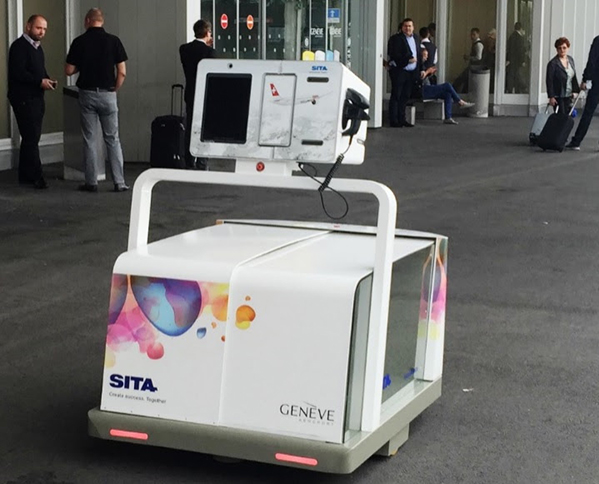 Passengers arriving at Geneva Airport in the past few days have received help with their bag drop from Leo, an innovative baggage robot developed by air transport IT provider SITA, which is being trialed outside the airport’s Terminal 1.
Passengers arriving at Geneva Airport in the past few days have received help with their bag drop from Leo, an innovative baggage robot developed by air transport IT provider SITA, which is being trialed outside the airport’s Terminal 1.
Leo is a fully autonomous, self-propelling baggage robot that has the capacity to check in, print bag tags and transport up to two suitcases with a maximum weight of 32kg. It also has an obstacle avoidance capability and can navigate in a high-traffic environment such as an airport.
Leo provides a glimpse into the future of baggage handling being explored by SITA Lab and is the first step to automating the baggage process from the moment passengers drop their bags to when they collect them. Using robotics and artificial intelligence, bags will be collected, checked in, transported and loaded onto the correct flight without ever having to enter the terminal building or be directly handled by anyone other than the passengers themselves.
Leo – named after the Italian Renaissance inventor and engineer Leonardo da Vinci who built what is now recognized as the world’s first robot – comes to the assistance of passengers as they approach the terminal building. Touching Leo’s Scan&Fly bag drop interface opens the baggage compartment doors to allow passengers to place their bags inside. After the passengers have scanned their boarding passes, the tags are printed and can be attached to the bag. With the bags loaded and tagged, the compartment door closes and Leo displays the boarding gate and departure time.
Leo then takes the bags directly to the baggage handling area where they are sorted and connected to the correct flight. The doors of the robot can only be reopened by the operator unloading the baggage in the airport.
The use of robots such as Leo means that in future fewer bags and trolleys will enter the airport terminal, reducing congestion and making airport navigation easier.
Dave Bakker, President Europe at SITA said: “Through the innovative work of the SITA Lab we are able to tackle some of the key challenges that face airports today. Leo demonstrates that robotics hold the key to more effective, secure and smarter baggage handling and is major step towards further automating bag handling in airports. Leo also provides some insight into the potential use of robots across the passenger journey in future.”
Massimo Gentile, Head of IT at Genève Aéroport, said: “In a busy airport such as Geneva Airport, the use of a robot such as Leo limits the number of bags in the airport terminal, helping us accommodate a growing number of passengers without compromising the airport experience inside the terminal. Leo also proves the case for increased use of robotics to make passengers’ journey a little more comfortable, whether it is checking in baggage, providing directions or helping them through the security process.”
Leo, which was built for SITA by BlueBotics, is part of SITA’s showcase of technology at the 2016 Air Transport IT Summit taking place from 24-26 May in Barcelona.
To watch Leo in action at Geneva Airport click on the following link: www.sita.aero/baggagerobot



